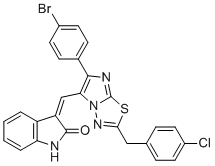
Disarib
CAS No. 1998149-15-7
Disarib( —— )
Catalog No. M13120 CAS No. 1998149-15-7
Disarib is a novel BCL2-specific inhibitor that binds predominantly to the BH1 domain.
Purity : >98% (HPLC)
 COA
COA
 Datasheet
Datasheet
 HNMR
HNMR
 HPLC
HPLC
 MSDS
MSDS
 Handing Instructions
Handing Instructions
| Size | Price / USD | Stock | Quantity |
| 100MG | Get Quote | Get Quote |


|
| 200MG | Get Quote | Get Quote |


|
| 500MG | Get Quote | Get Quote |


|
| 1G | Get Quote | Get Quote |


|
Biological Information
-
Product NameDisarib
-
NoteResearch use only, not for human use.
-
Brief DescriptionDisarib is a novel BCL2-specific inhibitor that binds predominantly to the BH1 domain.
-
DescriptionDisarib is a novel BCL2-specific inhibitor that binds predominantly to the BH1 domain, demonstrates strong affinity to BCL2, but not to other antiapoptotic BCL2 family members(BCL-xL, BCL2A1 etc.); is a novel BCL2 inhibitor with a unique mechanism of BCL2 inhibition.
-
In Vitro——
-
In Vivo——
-
Synonyms——
-
PathwayAngiogenesis
-
TargetBcl-2
-
RecptorBcl-2
-
Research Area——
-
Indication——
Chemical Information
-
CAS Number1998149-15-7
-
Formula Weight547.855
-
Molecular FormulaC26H16BrClN4OS
-
Purity>98% (HPLC)
-
Solubility——
-
SMILES——
-
Chemical Name3-((2-(4-chlorobenzyl)-6-(4-bromophenyl)imidazo[2,1-b][1,3,4] -thiadiazol-5-yl)methylidene)-1,3-dihydro-2H-indol-2-one
Shipping & Storage Information
-
Storage(-20℃)
-
ShippingWith Ice Pack
-
Stability≥ 2 years
Reference
1. Iyer D, et al. FEBS J. 2016 Sep;283(18):3408-37.
2. Vartak SV, et al. Biochem Pharmacol. 2016 Dec 15;122:10-22.
3. Vartak SV, et al. Biochem Pharmacol. 2017 May 1;131:16-28. doi:
molnova catalog



related products
-
Obatoclax
A potent inhibitor of Bcl-2 family with IC50s of 1-7 uM for Bcl-2, Bcl-XL, Bcl-w, Bcl-B, Mcl-1 and Bfl-1.
-
SW076956
SW076956 is a small molecule that selectively disrupt Beclin 1/Bcl-2 binding as compared to Bax/Bcl-2 and Bim/Bcl-2 binding and induces autophagic flux at concentrations with minimal cytotoxicity.
-
Mcl1-IN-2
Mcl1-IN-2 is an Mcl-1 inhibitor without a reported IC50 value.



 Cart
Cart
 sales@molnova.com
sales@molnova.com


